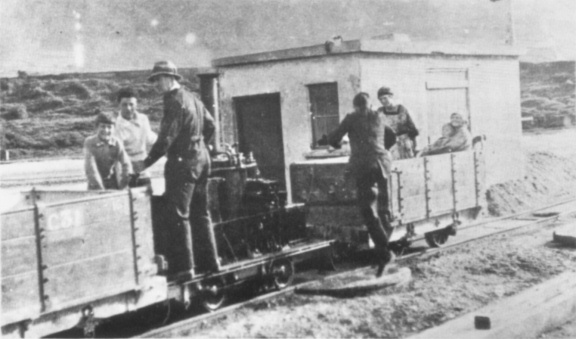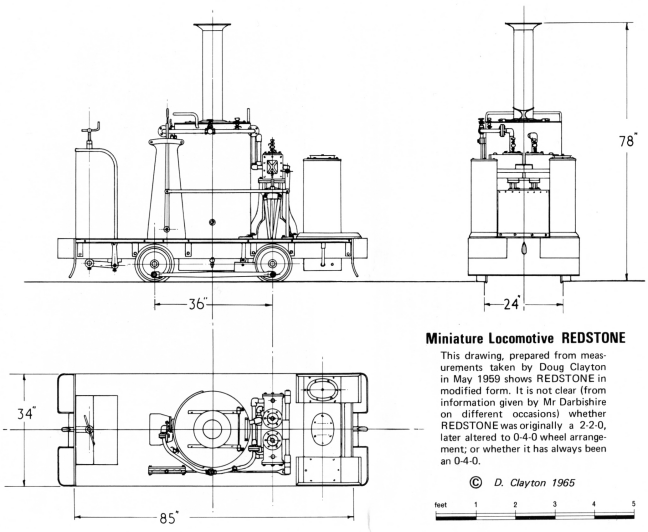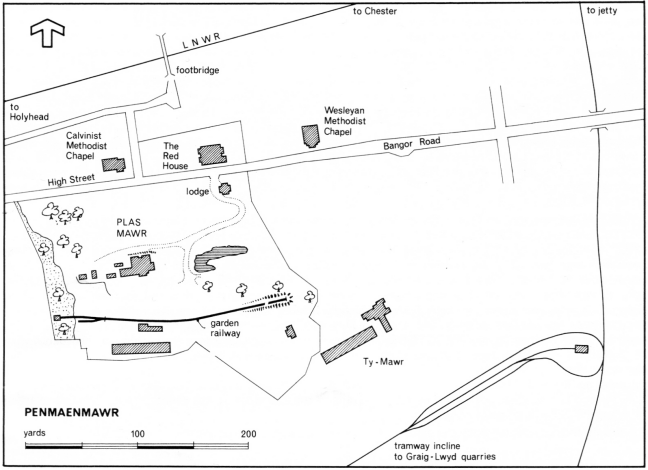
| THE INDUSTRIAL RAILWAY RECORD |
© JUNE 1974 |
REDSTONE
D. CLAYTON
Unique among the many narrow gauge steam locomotives which have graced the hills and valleys of North Wales, REDSTONE, until recently, was without doubt the least known. Hidden away for many years in the stable of a private house it had been seen by very few people indeed. I came across it some fifteen years ago but in deference to the wishes of its then owner, the late Stephen Darbishire, a discreet silence was maintained. Subsequently, a handful of members "discovered" REDSTONE and there has been a passing reference (though incorrect in its details) in an issue of "Model Railway News". In more recent years the locomotive came into the possession of Mr A.J. Hills, and was moved to Llanberis in February 1972 where it is now on display.
The Darbishire family is well known in North Wales, and Stephen Darbishire recalled that his grandfather had a railway ballasting contract way back in 1852. His father and uncle were in partnership and owned quarries at Graig Llwyd, Penmaenmawr (later Penmaenmawr & Welsh Granite Co Ltd) and Pen-yr-orsedd (later Pen-yr-orsedd Slate Quarry Co Ltd). Some of the De Winton and Hunslet locomotives at Graig Llwyd were named after their sons and daughters, and STEPHEN appeared on Hunslet 771 in 1902. Charlie, who went off to Singapore, didn't want an engine named after him but was remembered just the same by Hunslet 798 SINGAPORE. Stephen was later able to repay the compliment and two Kerr Stuart locomotives at PWG's Trevor Quarries were named after his son Michael and nephew Mark.
It is not surprising that Stephen as a boy was very interested in engines and railways. In correspondence he said, "I saved up my pocket money and bought a twin-cylinder marine type engine casting. I asked my father if it could be made up into a "coffee-pot" loco. He agreed, and the head foreman at Penmaenmawr Quarries said he would construct it in his spare time. While he was doing this my brothers and I helped to build the railway which my father had levelled for me and set out the curves. The foreman, whose name was Redstone, the eventual name of the locomotive, made room in a shed at the back of his cottage to erect the engine. My brothers and I used to go along in the evenings during the holidays and help him with anything we could do. I bought the parts about 1903 and on 5th September 1905 it was on the rails in the garden with about 200 yards of track ready for its trial run."

REDSTONE in use on the garden railway at Plas Mawr. (collection C.H.A. Townley)


Layout of the grounds at Plas Mawr, the Darbishire's house at Penmaenmawr, showing the railway that REDSTONE was used on. A wooden loco shed and coal shed were situated at the western end of the line.
During the next few years visitors to the Darbishire's house (Plas Mawr) at Penmaenmawr would enjoy a tour of the gardens in two or three open wagons behind REDSTONE. But in 1920, when Stephen was appointed Quarry Manager at Trevor, he moved home to Trevor and sometime in 1921 REDSTONE went along too. It next turned a wheel the following year, not in the garden but at the quarries where it went for trials. A shorter chimney was fitted to enable it to pass under the mill hoppers but, as Mr Darbishire remarked, "it was only a small toy of an engine and extra weight had to be added to prevent the wheels from slipping." It was rather prone to derailment on curves as it had no springs, and lack of an ashpan caused a few anxious moments when it was tried out a few weeks later on the wooden pier at the foot of the incline from the quarries. REDSTONE's success with runs of four 10‑ton wagons normally handled by fourteen men was a satisfactory demonstration of the value of locomotive traction, and the Company then proceeded to purchase a number of petrol locomotives for this lighter traffic. (The "main-line" was already worked by steam locos at this time.)
REDSTONE is essentially a 2ft gauge model of a 3ft gauge De Winton, for it has the characteristic inside frames of the 3ft gauge locomotive rather than the outside frames used on the standard 2ft gauge product. (The De Wintons at Graig Llwyd copied by foreman Redstone ran of course on 3ft gauge tracks.) REDSTONE has no springs of any sort as with a direct drive vertical engine it would not be practical to have the axle moving up and down when the cylinders are fixed. Only the rear of the rear wheels are braked and the rear bunker arrangement with a screw handbrake fitted into it is standard De Winton practice, as is the method of firing through a flap-door in the footplate with a chute to the firegrate. In fact, apart from the cylinders being arranged free standing and not attached to the boiler the engine presents all the usual De Winton characteristics. Lever reverse is fitted and two notches in the lever quadrant allow for some measure of "notching up"; the regulator handle is very tiny indeed. The front elevation drawing shows the original tank - not a conventional well tank - set between the frames (as on standard De Winton locomotives) and flanked by two extra water tanks. These, together with some blocks of metal underneath, were fitted at Trevor to increase adhesion. Larger tyres with wider tread and increased flanges were also fitted at Trevor to the disc pattern wheels: the original wheels may have been one‑piece castings. The side rods, wide in the centre and tapering towards the ends, have a form of bearing with non‑adjustable brasses; and these are understood to have been fitted at Trevor. The drawing shows REDSTONE in its modified form except for the original chimney: this is hinged to the boiler which contains 68 brass tubes. Leading dimensions are: cylinders, 4in diameter by 6in stroke; wheels, 1ft 11in diameter; length over buffers, 7ft 10in.
REDSTONE worked at Trevor Quarries for probably little more than a month and then stood idle for about a year until Mr Darbishire had it taken back home. There, many years later, I was fortunate to come across it in the course of my researches into De Winton locomotives. During a visit to the Penmaenmawr Quarries I was told of a locomotive built there and was advised to contact Mr Darbishire for details of locomotives at Trevor. This I did, and the existence of REDSTONE came to light with Mr Darbishire's reply to my letter. The thrill of one's researches becomes more exciting when a steam locomotive whose existence is unknown comes to light.[*] Mr Darbishire offered facilities to see this unique machine and this was taken at the earliest opportunity on 15th May 1959, when the full story came to light. Later a few members were invited to see REDSTONE and, aware of the special interest attaching to his locomotive, Mr Darbishire offered to loan it to one of the preservation societies for exhibition. Unfortunately this offer was not taken up and REDSTONE remained at Trevor. After Mr Darbishire died the locomotive was acquired by Mr A.J. Hills and now forms part of his collection housed at Llanberis. Currently it looks a little forlorn but at least one can now look forward to the day when it will eventually be restored to something approaching its original condition.
I should like to acknowledge the assistance of N.L. Cadge in the preparation of this article.
* I had the very same feeling in 1959 on locating some long-forgotten Vulcan Foundry and Beyer Peacock locomotives way up in the hills of Northern Spain. Ahrons, too, writes most vividly of his visit about 1905 to a "ghost" shed on the North Eastern Railway where some thirty engines stood, silent and deserted,- the shed was at "a half-hidden recess in the hillside" which was "always within sound of the surf beating upon the rocks" Whilst not everyone has been able to make a real "find", some of us may be able to recall an exciting moment in the pursuit of our hobby. Suitable reminiscences will be considered for publication. - KPP.
'Mr R.K. Davis [of 68 Mark Lane, London] ... has ... to submit to unreserved sale by public auction ... FOUR LOCOMOTIVE ENGINES and THREE TENDERS (adapted to the common gauge) manufactured by Messrs Braithwaite, Milner & Co upon Berry's principle and similar to the engines used on the London & Birmingham Railway... They are now lying at the Marble Crane Wharf, St Katherine's Docks, having lately arrived from the continent where they have been in use a short time, and are not for sale on account of any defect in their construction, but in consequence of the company to which they belong ceasing their operations.' ("Mining Journal," 10th July 1841. - MJM)
'The progress of the works of Herr Krupp at Essen may be said to be one of the marvels of modern industry. ... There are eight separate and distinct departments belonging to this enormous concern. In the first place, we have the vast extent of workshops at Essen; secondly, three coal mines at Essen and Bochum; thirdly, no fewer than 547 iron ore mines in various parts of Germany; fourthly, several iron mines near Bilbao, in Spain; fifthly, an extensive series of smelting furnaces; and sixthly, the ranges at Meppen for the testing of the Krupp guns. ... There are thirty-seven miles of railway in the works, on which the traffic is performed by eighty-eight locomotive engines, and a park of 893 luggage wagons.'
("The Engineer," 7th August 1885. - MS)